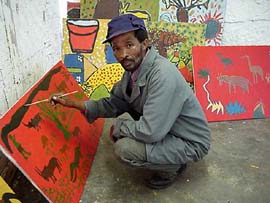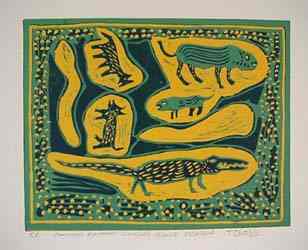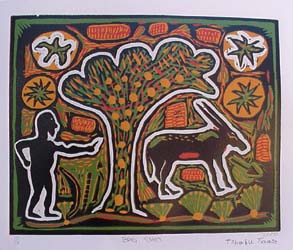 TSHABU (Tshabu Tãse)
TSHABU (Tshabu Tãse)
"As a young boy, I once killed a bird with a catapult because I needed food. When I held it in my hand I saw that it was very beautiful. I wanted to keep it, so I tried to make a wooden sculpture of it and painted it. Only then did I cook it and ate it, because it was food."
When Tshabu Tãse saw the bird he was about to eat, he was touched by its beauty. At that moment he decided he wanted to be a woodcarver. It was the only form of art familiar to him at that stage. Much later he realised there are other ways to preserve and give expression to esthetic feelings. He learned his woodcarving skills from his father who showed him how to look at a piece of wood and recognise an animal in it. For Tshabu almost every piece of wood has got something inside that can be brought out if you know how.
"You must feel the wood in your heart to know what to make from it."
He feels great respect for his father who used to make beautiful chairs and tables from wood. As a child he loved to make cars from wire and tins but most of all he loved the cars and animals he made from wood. He was born in 1963 on the farm D'Kar, where his father made a living as a leatherworker at the small mission station situated there. He grew up between the mission station and the surrounding farms where he often went with his grandparents. He never went to school and feels that he has a disadvantage not being able to read.
Tshabu works full-time at the Kuru Development Trust as a maintenance man. He joined the Kuru Art Project in 1997. He practises his art in his spare time. In 1999 he attended a carpentry workshop in Kanye, Botswana, where his skills were noticed. He makes his art with all his heart and head. Before he starts he "speaks" in his head.
He knows the lino printmaking technique by now but is still uncertain about painting. He usually depicts the animals he encountered in his life as well as the culture of the San. Although he is not a dancer or musician himself, he loves to listen to the traditional music and to watch the dancers around the fire in the evenings. In this way he can observe them better to know how to depict them.
As a carpenter Tshabu is also responsible for the stretch frames the other Kuru artists use.
| |
 |
|
| |
| |
Common animals during rainy season - reduction linocut - no date |
|
| |
| |
 |
|
| |
| |
Dog and hartebeest in rainy season - reduction linocut - no date |
|
| |
| |
 |
|
| |
| |
Bad shot - reduction linocut - 2000 |
|
| |





